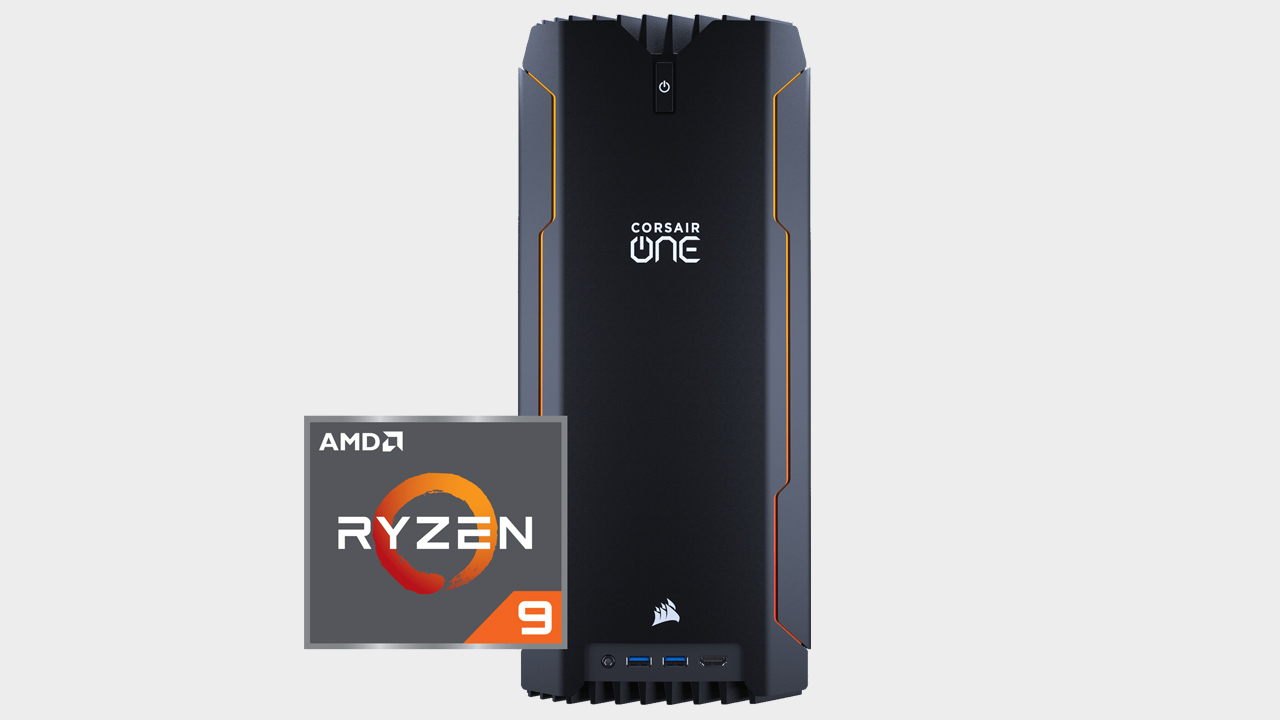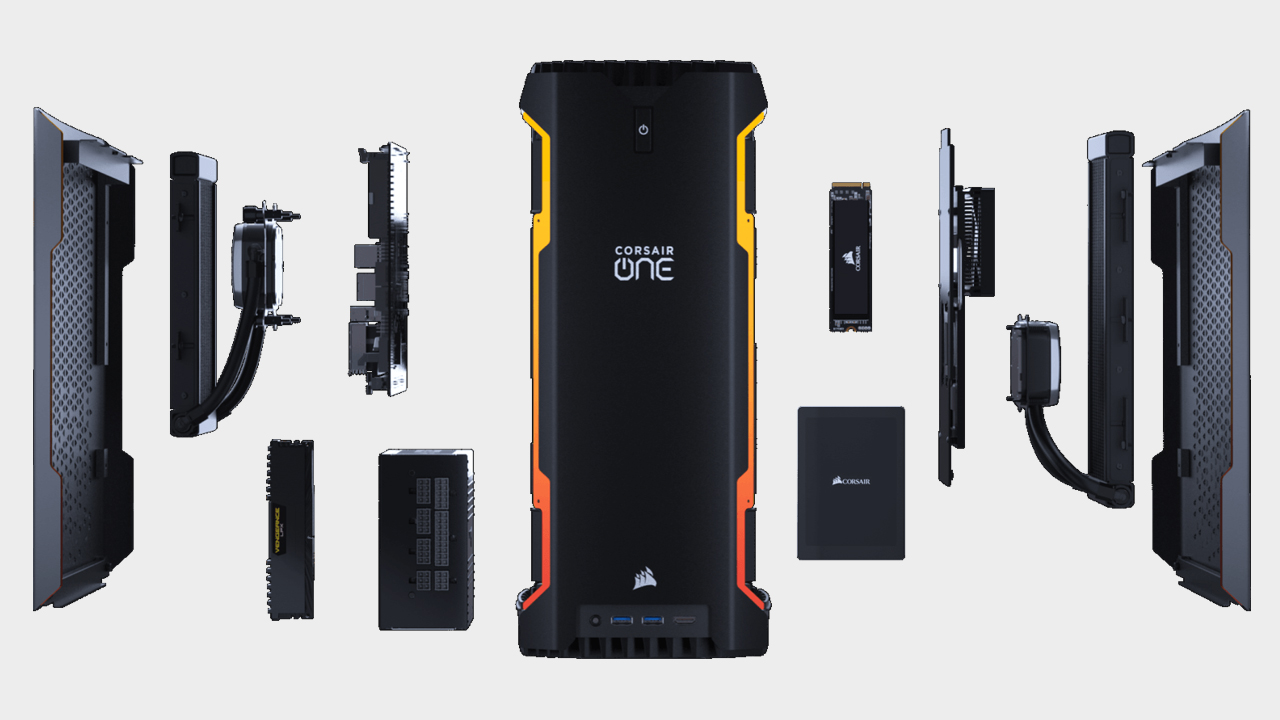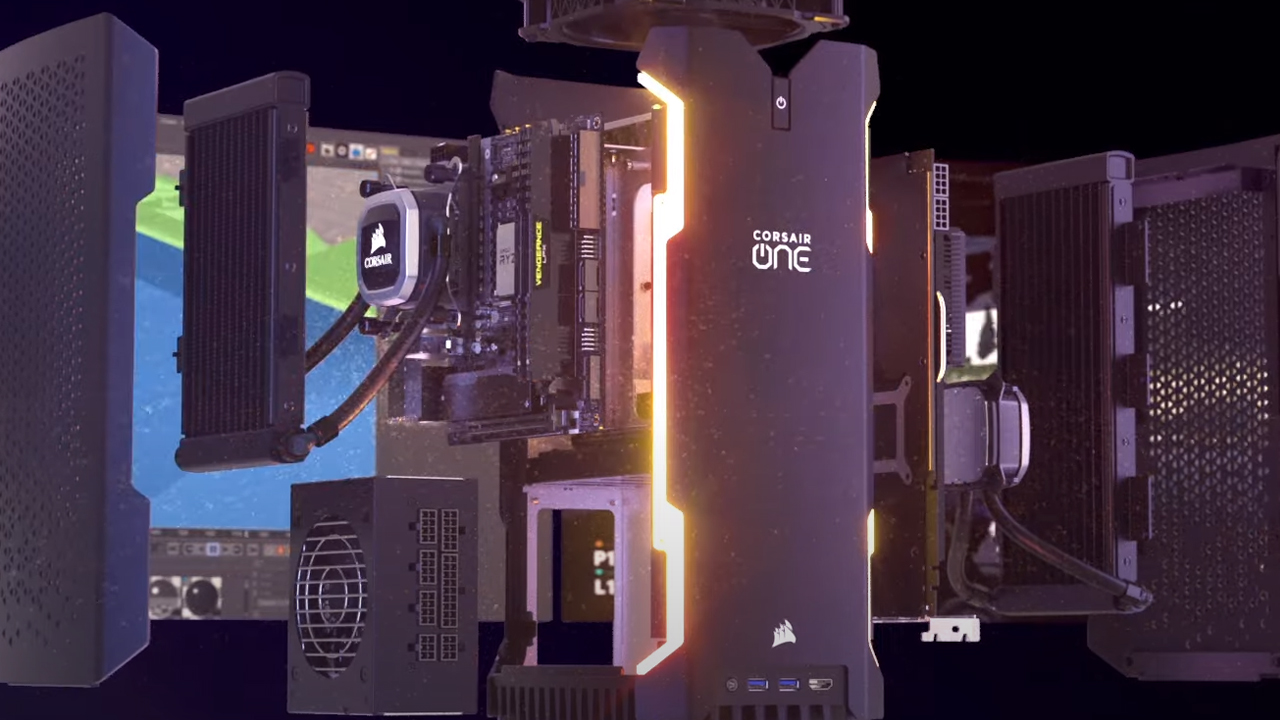GamesRadar+ Verdict
An almighty gaming system (with an equally mighty price tag).
Pros
- +
Incredible gaming performance
- +
Takes full advantage of PCIe 4.0
- +
Liquid cooling works well
- +
Tiny desktop footprint
Cons
- -
Difficult to customize
- -
Seriously expensive
Why you can trust GamesRadar+
In case you’re not already familiar with the brand, it’s worth noting before I get into the meat and bones of this Corsair One a100 review that there are already multiple Corsair One models available on the market. There have been for months. And even though this version of the One doesn’t seem to bring much to the table upon first inspection, under that gunmetal exterior lies a very different beast.
See, the Corsair One a100 is the very first model to pack an AMD Ryzen processor rather than the Intel Core chips seen in the One iXXX series (that’s ‘i’ for Intel and ‘a’ for AMD, as you’ve probably figured out). This isn't the company dipping a toe in the water, either. Corsair has jumped in at the deep end, and the a100 definitely lives up to expectations. It's one of the best gaming PC pre-builds you can get.
- US deals: Browse the full Corsair One range
- UK deals: Browse the full Corsair One range
Features

Our review unit featured the following specs:
Processor: AMD Ryzen 9 3950X
Graphics: Nvidia GeForce RTX 2080 Ti
Memory: 32GB DDR4 Corsair Vengeance LPX
Storage: 1TB Corsair Force MP600 M.2 PCIe SSD (Boot) + 2TB 5400RPM HDD
Ports (front): 2x USB 3.1 Gen 1, Combo Headphone/Mic, HDMI 2.0a
Ports (rear): 4x USB 3.2 Gen 2 (3x Type-A and 1x Type-C), 4x USB 3.1 Gen 1, HD Audio, Ethernet, 3x DisplayPort
Connectivity: Gigabit Ethernet, WiFi 6, Bluetooth 5.0
Weight: 7.38kg
Corsair selected the cream of the crop when it came to this gaming PC’s components, starting with AMD’s top-of-the-line Ryzen 9 3950X processor. It’s a 16-core powerhouse that chews through CPU-intensive tasks and finally rival’s Intel’s throne when it comes to CPU-bound gaming (as you can see from our Total War: Warhammer II benchmark).
Joining that processor is the graphics card we all dream of, the RTX 2080 Ti. Even without pairing it with such a powerful processor, that means this gaming rig is 4K ready straight out of the box. It’s also the best ray tracing performance available on any single GPU right now.
Both of these components are cooled via dedicated liquid cooling solutions, each one routing to a radiator on opposing sides of the case. Even thrashing the hardware with benchmarking tests didn’t see our core temps running too high, although the solid metal grille at the top of the case did get quite warm.
Backing up the pricey CPU and GPU are a host of similarly powerful components. Memory is handled by two sticks of the manufacturer’s own Vengeance LPX, totalling 32GB, while the power supply and 1TB SSD are also from Corsair. A 2TB secondary hard drive means you’ll have plenty of room for games.
All of this is connected via an ITX X570 motherboard squeeze into the center of the case.
Design

The exterior casing and interior layout are no different to previous Intel-powered iterations of the One, but that’s not a point against it. The sleek dark metal of the a100 exterior looks fantastic, with subtle RGB lighting and perforated side channels that maximise airflow.
There’s only one dedicated fan here, however - a Corsair maglev fan mounted horizontally in the roof of the case. That's because the a100's interior design allows for superior convection cooling. It isn’t noisy, either; the One runs quiet even in resource-intensive games.
Inside the case, the layout is just as innovative today as it was when the first Corsair One was released. A flexible PCIe riser extends from the motherboard slot around to the other side of the case, allowing the GPU to be mounted upright behind the motherboard itself. The use of space here is as economical as it gets.
The main problem with this ultra-compact design is that it’s extremely difficult to upgrade or customize further down the line. Just getting the case open is a stressful experience, let alone detaching the liquid cooling blocks on the processor and graphics card. Swapping out a drive or the memory shouldn’t be too difficult, but don’t expect this to be an easily upgradeable system.
Performance

As expected, the a100 dominates gaming benchmarks. 4K is definitely an option in most games, so if you’re looking for the best way to experience that upcoming Horizon Zero Dawn port, this could be what you need.
4K performance sits between 50 and 60 frames per second, perfectly adequate for most single-player games. Ray tracing performance is also good (although it will impact framerates in games significantly, so 4K RTX still isn’t really an option).
If you’re into twitchy shooters, dropping down to 1440p will see you pushing 90 fps or more in just about everything. If you’ve got a monitor with a crazy high refresh rate, going down further to 1080p will give you stupidly high framerates in most games.

Cinebench R15 Multi (Index): 3,783
CrystalDisk QD32 Sequential Read (MB/s): 4,969
CrystalDisk QD32 Sequential Write (MB/s): 4,270
3DMark Fire Strike (Index): 28,506
3DMark Fire Strike Extreme (Index): 16,069
3DMark Fire Strike Ultra (Index): 8,662
3DMark Time Spy (Index): 13,104
Total War: Warhammer II: 1080p - 91fps | 1440p - 88fps | 4K - 60fps
Tom Clancy's The Division 2: 1080p - 149fps | 1440p - 103fps | 4K - 56fps
Metro Exodus (RTX off): 1080p - 121fps | 1440p - 94fps | 4K - 55fps
Metro Exodus (RTX on): 1080p - 88fps | 1440p - 59fps | 4K - 36fps
No big news so far, then. Which is to be expected; with a price tag of thousands, not to mention a 2080 Ti GPU, we’d be worried if the review a100 we were sent didn’t destroy our gaming benchmarks.
There’s something else of interest here, though: the SSD. It’s a Corsair Force MP600 M.2 drive, with PCIe 4.0 support - a feature that has so far remained exclusive to Ryzen systems. PCIe 4.0 means that the drive can hit far higher speeds than any SSD in an Intel machine.
What does that mean for you? It means games load faster and files transfer quicker, up to a maximum of nearly 5GB/s. In practice, this likely won’t decrease your load times by much compared to a PCIe 3.0 M.2 SSD, but it blows SATA drives and HDDs out of the water.
As a result, the Corsair One a100 is staggeringly good. So good that I’m angry Corsair won’t let me keep it. It’s also staggeringly expensive, but it backs that up with great performance and offers a somewhat unique proposition; pay that little bit extra for the most compact design on the market.
Compared to the gaming desktop I have at home, the One takes up barely any desk space at all - and it’s more powerful than my system by far. It feels perfectly suited to streamers and pro gamers; if you’ve got the cash and need a serious home gaming setup, it could be the perfect option.
- US deals: Browse the full Corsair One range
- UK deals: Browse the full Corsair One range
Christian is a writer for Maximum PC, but also writes in a freelance capacity for a number of other sites including GamesRadar, PC Gamer, and TechRadar. He knows the PC gaming space inside out, particularly when it comes to hardware including PC builds, keyboards, and other peripherals.



